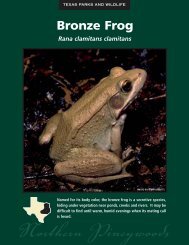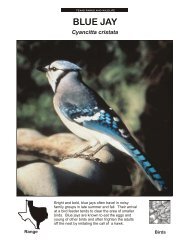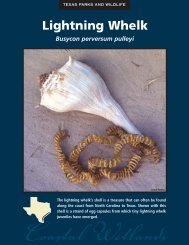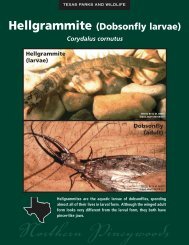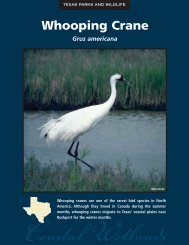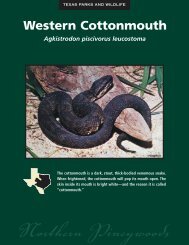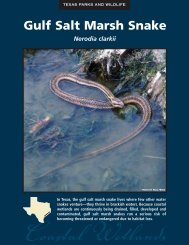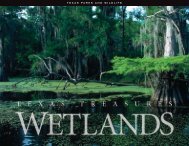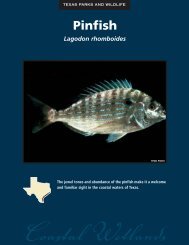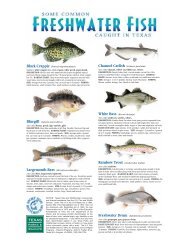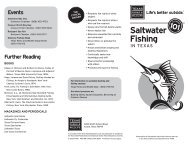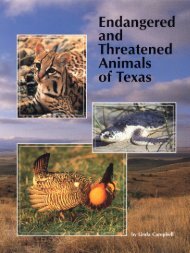Print Northern Pineywoods Species Fact Sheet Set - The State of ...
Print Northern Pineywoods Species Fact Sheet Set - The State of ...
Print Northern Pineywoods Species Fact Sheet Set - The State of ...
You also want an ePaper? Increase the reach of your titles
YUMPU automatically turns print PDFs into web optimized ePapers that Google loves.
SweetgumLiquidambar styracifluaAPPEARANCEHABITATHeight: 80 to120 feet (24 to 36 m)Distinguishing Characteristics• Star-shaped leaf with 5 to 7 lobes• Dark green in spring and summer• Brilliant gold and orange in autumn• Thick, gray-brown, deeply furrowed bark• Conical shape in young trees and oval shape in mature treesLIFE HISTORYRange: Texas east to Florida and north toNew YorkGrowth habit: Early growth is very rapid, but the tree<strong>of</strong>ten falls behind other species aftermaturity.Flowers: March through May; very small greenblossomsFruit: Fruit are shaped like horny globes.At least 25 species <strong>of</strong> birds, varioussquirrels and chipmunks eat the fruit.Seeds: Trees begin to produce seeds after 20 or30 years and continue to bear seedsuntil about 150 years old. Seed balls,under the best conditions, may hold upto 56 seeds. Sweetgum stumps androots sprout easily, especially after thestem is killed, cut or heavily damaged.Sweetgum are found in bottomland hardwood and riparian(streamside) areas. Although it prefers moist soil, it is extremelyadaptable and will grow in dryer areas.SWEETGUM AND THEENVIRONMENT<strong>The</strong> genus, Liquidambar, can be found here and there all overthe <strong>Northern</strong> Hemisphere. <strong>The</strong>re are more than 20 species <strong>of</strong>sweetgum identified. A Liquidambar fossil found in Greenlandis more than 55 million years old. Sweetgum <strong>of</strong>ten grow inmixed stands with maple, box elder, and pine trees. Becausesweetgum is a fast growing, fairly disease resistant species, itadapts well to areas that have been disturbed and is sometimesused in reforestation projects.SWEETGUM AND PEOPLENative Americans used to chew the hardened resin from thebark <strong>of</strong> sweetgum trees obtained by peeling the bark andscraping <strong>of</strong>f the resin-like solid. This gum was used medicinallyas well as for chewing gum. <strong>The</strong>y also made various teas andmedicines to treat dysentery and diarrhea from bark and roots<strong>of</strong> sweetgum. It is reported to be excellent for healing wounds.<strong>The</strong> wood <strong>of</strong> the sweetgum is second only to oak in being usedfor furniture, wooden boxes, musical instruments, flooring, andcomposite products. It has been cultivated in North Americasince the 1680s.PWD LF D0200-848W (8/02) NOTICE: Texas Parks and Wildlife Department receives federal financial assistance from the U.S. Fish and Wildlife Service. Under Title VI <strong>of</strong> the Civil Rights Act <strong>of</strong> 1964, Section 504 <strong>of</strong> the RehabilitationAct <strong>of</strong> 1973, Title II <strong>of</strong> the Americans with Disabilities Act <strong>of</strong> 1990, the Age Discrimination Act <strong>of</strong> 1975, and Title IX <strong>of</strong> the Education Amendments <strong>of</strong> 1972, the U.S. Department <strong>of</strong> the Interior and its bureaus prohibit discriminationon the basis <strong>of</strong> race, color, national origin, age, disability or sex (in educational programs). If you believe that you have been discriminated against in any Texas Parks and Wildlife Department program, activity, or facility, or if youdesire further information, please call or write: <strong>The</strong> U.S. Fish and Wildlife Service, Office for Diversity and Civil Rights Programs - External Programs, 4040 N. Fairfax Drive, Webb 300, Arlington, VA 22203, (703) 358-1724.



